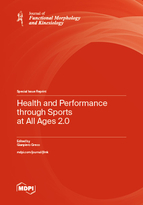Health and Performance through Sports at All Ages 2.0
A special issue of Journal of Functional Morphology and Kinesiology (ISSN 2411-5142). This special issue belongs to the section "Sports Medicine and Nutrition".
Deadline for manuscript submissions: closed (31 December 2023) | Viewed by 17186
Special Issue Editor
Interests: exercise; wellbeing; physical activity; physical fitness; psychological fitness; human performance; healthy lifestyle; tactical population
Special Issues, Collections and Topics in MDPI journals
Special Issue Information
Dear Colleagues,
It is with great enthusiasm that I am announcing a Special Issue 2.0 in JFMK with the aim of examining the effects of sports practiced at all ages on health and performance. Health, fitness, and exercise have become very important topics in the field of research. Sports-related professionals require the support of evidence-based knowledge to respond satisfactorily to the population practicing individual, team and combat sports. Topics of interest include strength training, exercise technique, conditioning methodologies and programming, performance recovery, skill development, body composition, nutrition for performance and health, and health- and performance-related testing. We welcome original research, meta-analysis, reviews, and brief reports.
Dr. Gianpiero Greco
Guest Editor
Manuscript Submission Information
Manuscripts should be submitted online at www.mdpi.com by registering and logging in to this website. Once you are registered, click here to go to the submission form. Manuscripts can be submitted until the deadline. All submissions that pass pre-check are peer-reviewed. Accepted papers will be published continuously in the journal (as soon as accepted) and will be listed together on the special issue website. Research articles, review articles as well as short communications are invited. For planned papers, a title and short abstract (about 100 words) can be sent to the Editorial Office for announcement on this website.
Submitted manuscripts should not have been published previously, nor be under consideration for publication elsewhere (except conference proceedings papers). All manuscripts are thoroughly refereed through a single-blind peer-review process. A guide for authors and other relevant information for submission of manuscripts is available on the Instructions for Authors page. Journal of Functional Morphology and Kinesiology is an international peer-reviewed open access quarterly journal published by MDPI.
Please visit the Instructions for Authors page before submitting a manuscript. The Article Processing Charge (APC) for publication in this open access journal is 1600 CHF (Swiss Francs). Submitted papers should be well formatted and use good English. Authors may use MDPI's English editing service prior to publication or during author revisions.
Keywords
- exercise
- physical activity
- physical fitness
- physical education
- sports performance
- human performance
- resistance training
- endurance training
- body composition
- active and healthy
- ageing combat sports







